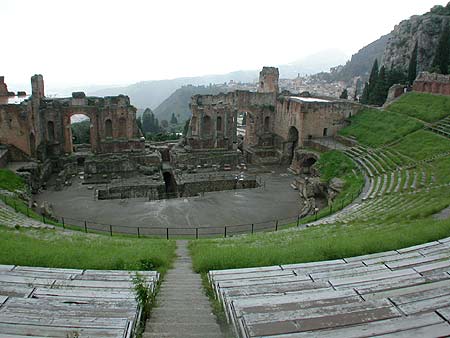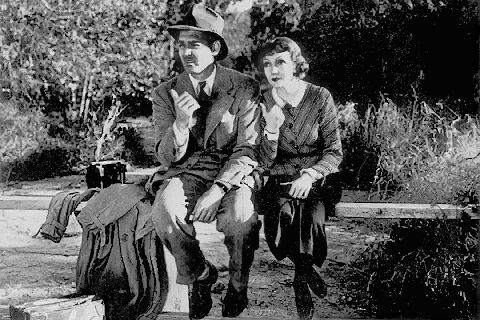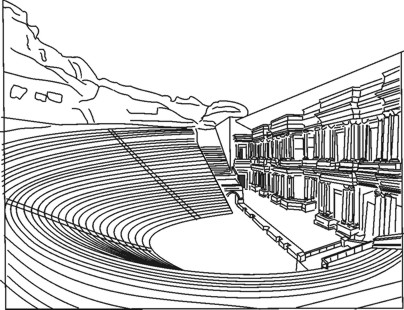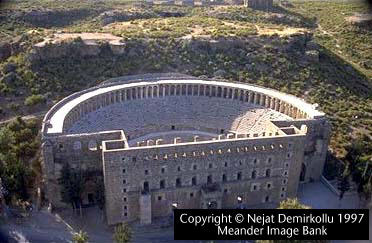 |
|||
|---|---|---|---|
|
|
Above blueprint courtesy of: http://www.honors.umd.edu/HONR218C/images/theatron.jpg.
Week One. Aristophanes' Birds
The scenery and setting at the theater was mostly done in the audience’s imagination. Besides costumes and the skene building, the setting was the natural scenery outside, where the theater was located. Essentially sitting on a hillside with mountains and trees in the background, in many ancient texts theaters beautiful and peaceful settings were compared to temples. The scenery added to the spectacle of the entire performance because most of the actual scenes took place in Athens, and the audience was already in Athens. If the scene was set in a different place, it was up to the imagination to get you there. The majority of the action took place on a stage area that was up from the orchestra. The orchestra is a round and flat floor at the base of the Greek theater. This is where chorus was. The large area gave them enough room for vivid dancing as well as instrumentation. Props like the “Mechane” or crane helped make some small effects for the audience to pick up on gods floating above, or the scene in Clouds where Socrates was seen suspended as he was trying to look down on the sun (24). Chaplin As an artist, Chaplin paints a portrait of the culture at the particular time through his use of scenery and social aspects used in his short films. “The Immigrant,” “The Count,” and “Easy Street,” all portray a feeling of poverty in a lower class setting. His portrayal and description of the behavior of a lower economic class is seen as vulgar and more violent than those of the upper or middle classes (357). The scenes that take place in “Easy Street” show a very poor neighborhood, with cops that are unfit to protect the people, heroine addicts living in a hole of an apartment, families and individuals that are stealing to eat, and just a general notion of helplessness as the population lets the tyrant bully run the place. Most of the movie takes place actually on one set which is Easy Street. The set is dark, dirty, and decrepit. The windows are boarded up, there are pot holes, everything is covered in filth. From the set alone the audience knows what economic class resides there. But by the end there is a change in the quality of the street after the Tramp defeats the antagonist. The street is cleaned, the windows are open and the entire set is brighter. These subtle changes turned a street of corruption into a street of hope. Another example from “The Immigrant,” shows how the immigrants coming over on boats were treated. With the Statue of Liberty in the background, they are brutally herded by guards on the boat (357), once again looking at class. Charlie appeals to all class levels, but the character he portrays is usually starting somewhere near the bottom, with comical scenes he creates that are funny but still get the point across of the characters’ living conditions. He appeals to other classes by having his character go from the bottom and intrude on events that he normally would not. Like the dinner in the mansion of “The Count.” The scene is full of characteristics of the lifestyle of the upper class, with tables full of food, a dance floor and fancy lights and dress. In this movie all of the sets in the mansion are as grand as possible, from portraits to dumb waiters to marble flooring. This helps to emphasize the staggering class difference among the characters, which is key to much of his plot. Chaplin’s vulgar actions and the violence between him and the tailor are so out of place any class could appreciate the comedy. Like the settings of Aristophanes' plays, Chaplin's sets are made to contrast between economic classes. They emphasize this difference because much of the comedy of their plots comes from the relationship between the rich and the poor, the couth and the ill-mannered. So it was vital to their productions that this is highlighted by every means necessary, including the sets.
Week Two. Menander's Dyskolos
The Roman theatre Menander had to work with was a large holding that seated about 17,000 spectators. It was open to the sky and did not have any curtains or lighting. A normal set was usually a city street with two or three houses opening to it. The actors performed on a stage area about 60 feet wide. It was raised above the level of the orchestra or dancing floor. A stage building with three doors and wings was used to define the outer limits of the stage.
In Dyskolos, the setting is rural and romantic. Pan’s shrine is real and the space between it and the houses were dictated by dramatic necessity. The space was needed because there were conversations and monologues that took place, like in line 395 when the cook Sikon is speaking, on the way to the shrine. The overall setting is outside of a small village. The shrine is depicted to be in a forest area, with Knemon and his farmland being the closest neighbor. The forest and farmland would have been hard to reflect with the stage and theatre Menander used, shown in the above picture as just some leaves on the ground, but the shrine was there, so a large portion, like in the plays of Aristophanes, would have had to of taken place in the imagination. Miller, Norma. Menander Plays and Fragments. New York: Penguin Books USA Inc., 1987. pg. 3-50. "It Happened One Night"
The scenery in "It Happened One Night" had an "on the road" theme. Ellen was running away from her father, and taking a bus to stay out of the public eye as much as possible. Setting for a majority of the scenes were on the bus, in a small rented room, or a rural scene in a small town the bus is rolling through. The above picture shows a more rural scene. The two characters had to ditch the bus, and are now in the countryside waiting for someone to give them a ride. Another example of the outdoor scenery in the movie is when they have to sleep in hay piles on a farm. This is out of place for both characters, but not so much of a contrast for Mr. Warne, being resourceful and at least knowing how to handle the situations. Ellen on the other hand is used to the urban, higher lifestyles. So when they are stranded in a tiny rural hotel or a bus station is a small town she has a difficult time reacting to the circumstances. The scenery goes hand in hand with how out of place she is while in the company of Mr. Warne. The settings force her to react to what she is not used to and makes apparent her personality flaws causing much of the comedy in the movie and eventually bringing about the best in Ellen and changing the audiences view of her. This forced change upon the wealthy Ellen is much like that of Sostratos in Dyskolos. In order for him to marry the girl which he loves he is put into situations of which he is not accustomed; farming, fetching water, and helping his future father-in-law out of a well. This accentuates the difference in class between him and the family of his love, but eventually helps to make him a stronger person, gain the approval of the girl's family, and eliminate his character flaws in the eyes of the audience. This is very similar to the image of Ellen being a spoiled brat in the first half of It Happened One Night disappearing bye the end of the movie. Without transformations like these it is difficult for audiences of lower class to empathize or even sympathize with characters of higher class. Therefore these situations and settings are crucial in the progression of the story and character.
Week Three. Plautus's Theaters
The theaters of Rome had much in common with those of Greece. They were both rounded and had sloping seats for the purpose of making the play audible to a very large crowd. But there some very distinct differences. Greek Theaters were carved out of a hillside while Roman theaters were built up from solid ground using either cement or stone. Also the orchestra is larger because the structures were used for other events which required more space. Below is a diagram of the average Roman Theater and a picture of a theater itself. You can them to the Greek examples above.
Photos obtained courtesy of http://veneziainscena.provincia.venezia.it/dyskolos_file/image010.jpg The scenery used in ancient times was a little more basic and simple than what we are capable of doing these days in the movie business. Special effects have made anything possible. One could have the setting of an entire movie on the Sun itself, and as far as the computers are concerned, it could happen. But in the ancient plays, the music, words, and costumes were the most important aspect that got the setting across. The Roman Comedies took place in a Greek town. They could not do much as far as buildings and a set goes, so the costumes were important for the illusion, the spoken word and the manner of speaking was important, as well as the music. It was these three things that helped the audiences' imagination take them to the place the play was supposed to be. Scenery for "Iran Man" Like most roman comedies, the setting of the play was a Greek town, Athens. A street was portrayed on stage, much like those used in Menander, and had two house doors. In the notes at the beginning of the text we read, it was suggested that an object was needed on the right side of the stage for characters to hide behind. Einstein, Cherry, and Fat Jack all hide behind something, and a dumpster is suggested in the notes. With the capabilities they had back then, the set was just to help add to the illusion.
"Road to Morocco" The scenery of the movie was very ethnic, taking place in Morocco. Along with the costumes, the setting used stereotypes to help portray a different culture. Many scenes took place in a palace, with architecture and styles that would not have been very prominent in America at that time. People were riding camels and horses everywhere, the market place was a different, vibrant setting. The two main characters even have to walk through the desert to ultimately stumble upon an oasis. The comedy was emphasized by the fact that Crosby and Hope were not from the area.
|
||
For questions or comments, please contact John Gruber-Miller |
|||






